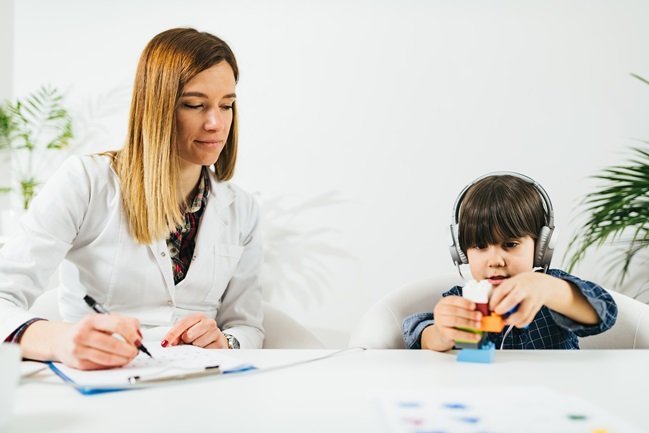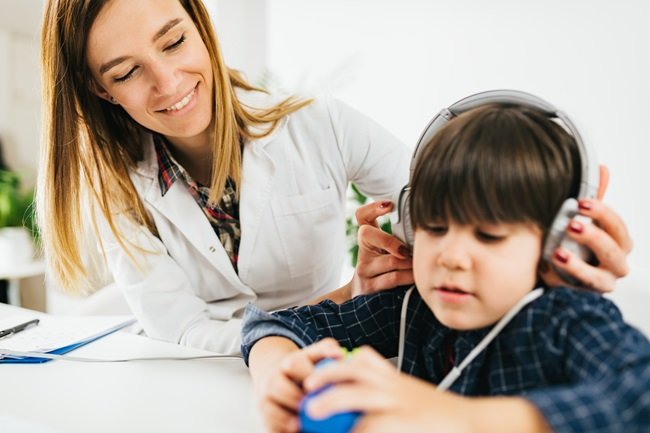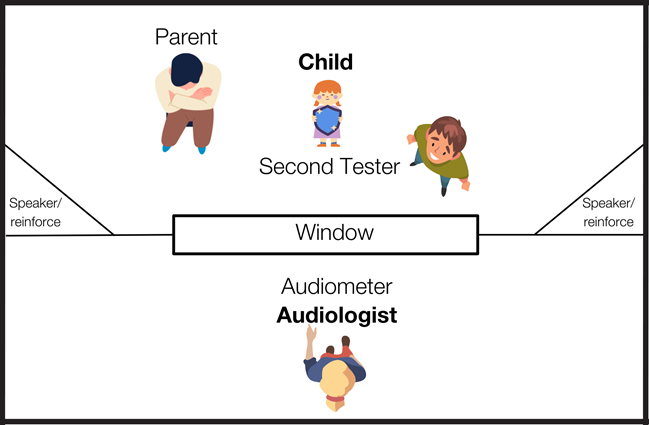Conditioned Play Audiometry (CPA) is an effective way to test young children’s hearing abilities. This method allows audiologists and other professionals to engage children in playful activities while gathering important auditory information.
This guide is for professionals new to CPA or those needing a refresher.
What is Play Audiometry?
Conditioned Play Audiometry (CPA) is a hearing test for children between the ages of 2 and 5. It involves connecting auditory signals to play activities. In traditional hearing test methods, test subjects respond to tones by raising a hand or pushing a button. CPA creates a comfortable and engaging environment by adding fun and interactive elements.
During CPA, instead of raising a hand or pushing a button to respond to a pure tone stimulus, the child performs a play activity like dropping a block in a bucket. Like other behavioral hearing tests, such as visual reinforcement audiometry (VRA), CPA requires conditioning.
During the conditioning phase, the test stimulus (pure tone) is paired with a play activity. The goal is for the child to eventually respond to the sound by doing the activity on their own.

Who Conducts Conditioned Play Audiometry CPA?
Either an audiologist or a speech-language pathologist (SLP) conducts play audiometry. When SLPs perform hearing screenings, adding play enhances results reliability. SLPs can also prepare children for audiological evaluations by engaging them in selected play audiometry tasks before the actual test session.
How Does CPA Work?
During a CPA session, the audiologist uses toys, games, or activities that are appropriate for the child's age.
The test stimuli typically consist of sounds presented at different frequencies and intensities through headphones or speakers. When the child hears a sound, they are instructed to complete a play activity. This could involve putting a block in a bucket or putting a peg in a hole. These actions indicate the child's ability to detect and discriminate sounds of varying pitches and volumes.

Key Components of CPA:
- Playful Environment: CPA sessions are conducted in a child-friendly space with toys, colorful visuals, and fun activities to create a relaxed atmosphere.
- Audiologist Interaction: Skilled audiologists are pivotal in guiding children through the assessment process, providing encouragement, and adapting the activities based on individual responses.
- Stimulus Presentation: Auditory stimuli are presented at controlled intensities and frequencies using specialized audiometric equipment, allowing for precise evaluation of the child's hearing thresholds.
- Positive Reinforcement: Throughout the assessment, positive reinforcement techniques, such as praise and rewards, are used to encourage the child's cooperation and maintain their attention.
How to do Conditioned Play Audiometry
Here's a step-by-step guide to conducting CPA using an example with Lisa, a 3-year-old child:
- Setup: Lisa sits independently in a chair inside an audiometric booth, with her mother seated behind her as a supportive presence. The parent is instructed to not participate or prompt during the testing.
-
Staff Presence: During CPA, either an audiologist and an assistant or two audiologists are present. One audiologist sits in front of Lisa, while the other is positioned outside the booth or on the other side of the sound booth with a window for observation. One audiologist will guide the child through the play activity, while the other operates the audiometer to present pure tone stimuli and record the results.

Conditioned Play Audiometry setup
- Instructions: The audiologist or assistant gives Lisa simple instructions, such as, "Lisa, you'll hear some 'birdy' sounds. When you hear the sound, drop the block in the bucket. Drop the block in the bucket every time you hear the birdy sound, even if it's very quiet." The audiologist may demonstrate the task themselves to help Lisa understand.
- Preparation: The audiologist places headphones on Lisa and gives her a block to hold. Using "hand-over-hand prompting," the audiologist guides Lisa's hand towards the bucket whenever the sound plays, instructing her to drop the block. The audiologist may offer positive feedback like "good listening" or use a Visual Reinforcement Audiometry (VRA) system alongside the play technique.
- Conditioning: Through repeated prompting and reinforcement, the audiologist helps Lisa learn to respond to the sound by dropping the block into the bucket. This process continues until Lisa responds reliably and independently.
- Independent Response: Once Lisa is conditioned, the audiologist allows her to respond to the sounds independently, without hand-over-hand prompting. This phase tests Lisa's ability to carry out the task without assistance, indicating her hearing abilities.
- Test Protocol Recommendation: Due to children's limited attention spans, it's advisable to test one frequency in the right ear and then move to the left ear rather than attempting to complete all frequencies for one ear and then move to the other.
By following these steps and adapting them to the child's needs, audiologists can effectively conduct CPA to assess hearing in young children like Lisa.
Managing Play Audiometry Challenges
Assist children in waiting to respond: Play audiometry can be particularly challenging for younger children due to their limited ability to wait for stimuli. Typically, children in this age group lack developed behavioral inhibition skills. They're often holding a toy and are eager to play!
Audiologists may place their hand as a barrier in front of the child to help them wait. During conditioning, when a tone is presented, the audiologist removes their hand and prompts the child to respond. During testing, the audiologist keeps their hand in place. If the child has been conditioned, they'll move the audiologist's hand out of the way to perform the conditioned play response.
Choose an engaging activity: Choosing a suitable play activity for conditioning requires the audiologist's judgment. For instance, a 4-year-old might not be motivated by simply putting a peg in a hole. This older child may need a more engaging game, such as building a tower to knock down when they hear the pure tone.
Reconditioning: As time goes on, it's typical for conditioning to weaken and for the child's motivation to decrease, requiring the audiologist to keep a close eye on their performance. If conditioning diminishes, it may need to be reinforced. Additionally, the audiologist can provide continual verbal encouragement, like "You're doing fantastic! Keep listening!"
Keep it new and interesting: Introducing a new toy can also be effective if the child's responsiveness or motivation declines over time.
Play telephone: If the child can't tolerate wearing headphones, the audiologist may address this by detaching the headphones from the headband and playing the "telephone game," where they hold the phone to one ear at a time.
By merging playfulness with precision, CPA facilitates accurate diagnosis and promotes a positive and empowering experience for both children and their families.
Do you need guidance on equipment for assessing young children's hearing abilities? Our team of experts is ready to assist you.
Contact us
Other Good Reads: What Is Pure Tone Audiology?
Follow us on Social!



If you haven't already, make sure to subscribe to our newsletter to keep up-to-date with our latest resources and product information.